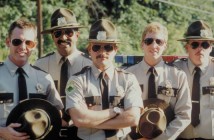
Editor’s Note: The following review is part of our coverage of TIFF’s fall film series Beyond Badass: Female Action Heroes. For more information, visit tiff.net and follow TIFF on Twitter at @TIFF_NET.
Eighteen years ago, Quentin Tarantino followed up his smash break-out hit Pulp Fiction with a cooler-received adaptation (his only to date) of Elmore Leonard’s novel Rum Punch retitled Jackie Brown. For some reason, many critics and fans didn’t take to this film, possibly because it was not perceived as being as stylistically innovative as Pulp Fiction or his debut Reservoir Dogs, or perhaps because it was more laid back than his two previous films. Either way, it’s still one of his least talked-about film, which is unfortunate. The film is just as electric as any of his other films, anchored by stellar performances with dialogue only Tarantino can write.
The story is of stewardess Jackie Brown (70’s Blaxploitation icon Pam Grier) who acts as a courier for arms dealer (which is a far more grandiose title than he deserves) Ordell Robbie (Samuel L. Jackson), bringing his money up from Cabo San Lucas, Mexico where his partner holds it for him. She’s detained by LAPD detective Mark Dargus (Michael Bowen) and ATF agent Ray Nicolette (Michael Keaton, who later reprised his role in Steven Soderberg’s adaptation of Leonard’s Out of Sight) who know exactly how much of Ordell’s money she has and also find a small amount of cocaine that she didn’t know was there.
The film is just as electric as any of his other films, anchored by stellar performances with dialogue only Tarantino can write.
 After she’s released from prison on bail, she’s escorted home by bail bondsman Max Cherry (Robert Forster). They form a bit of a connection and after he takes her home and she has an encounter with Ordell, she decides to work with Nicolette to arrest Ordell. She also starts to formulate a plan to get Ordell’s half-million dollars for herself. All this while Ordell’s old friend Louis (Robert De Niro) is coming to work for Ordell, but primarily spends his time with one of Ordell’s women he has set up, Melanie (Bridget Fonda).
After she’s released from prison on bail, she’s escorted home by bail bondsman Max Cherry (Robert Forster). They form a bit of a connection and after he takes her home and she has an encounter with Ordell, she decides to work with Nicolette to arrest Ordell. She also starts to formulate a plan to get Ordell’s half-million dollars for herself. All this while Ordell’s old friend Louis (Robert De Niro) is coming to work for Ordell, but primarily spends his time with one of Ordell’s women he has set up, Melanie (Bridget Fonda).
The art of the film is the slow-burn nature of it. Tarantino to that point had made two fast-paced crime/ganger pictures that barely took the time to breathe, but with Jackie Brown, he slowed down the tempo of the story, but not the dialogue, which remains rapid-fire. That is the fascinating juxtaposition of the film and what keeps you rooted while the complicated plot unfolds like a novel, unveiling each layer over time. It’s a delicate balance that few others, if any, could achieve.
In other hands, the scheme may not have seemed so well thought out and the success of it would have been dubious at best, but Grier plays Jackie so well that there is never any doubt that she will succeed.
First of all, the screenplay reads like a dream. It’s so good that it changed my feelings on the film, which on first viewing wasn’t particularly favorable. It’s one of the few screenplays that actually benefits from being extremely true to the source material. It’s so close that it makes reading the book difficult because it’s too much like watching the film and it’s difficult to let it stand on its own. It’s also one of the few films based on his own work that Leonard liked. Tarantino spoke once of being afraid to talk to Leonard after sending him the script, afraid he’d be unhappy with Tarantino changing the location to LA and making Jackie black and changing the title. Much to Tarantino’s surprise and delight, Leonard praised the script and approved of the changes.
Tarantino’s direction is also top notch here, as is to be expected. In his prior films, he emulated Godard, but here he’s pulling from another of his heaviest influences: Scorsese. You can see it in his angles, movements and framing that he’s paying homage to one of the great directors and enveloping it into his own style, which was now solidified with this film. He’s flashy in parts, but this film showed that he also knew the value of hanging back and letting the dialogue and actors carry a scene. He’d done this in parts of Pulp Fiction, but here he really sits back and enjoys what is unfolding. He consciously uses a lot of negative space, filling the smaller frame (he shot this in the smaller aspect ratio of 1.85:1 instead of his normal wide ratio of 2.35:1, creating a more intimate setting for the character and the story) often with just one character and blank space around them. Every shot is uncluttered, giving room for the actors and the dialogue to fly around.
Then come the performances. Grier was known as a powerhouse actress from the 70’s and her starring vehicles Coffy and Foxy Brown where she often was exacting bloody, violent revenge, but here she is at her most nuanced. She plays angry, sexy, cool, scared, vengeful and deceptive throughout the film, sometimes in the same scene. She makes it all seem effortless and while doing so, delivers the performance of her career. She anchors the film and thanks in no small part to her performance, she keeps the whole thing believable. In other hands, the scheme may not have seemed so well thought out and the success of it would have been dubious at best, but Grier plays Jackie so well that there is never any doubt that she will succeed.
Also stepping up to the plate and delivering a powerfully charismatic performance is Jackson. He makes Ordell seem like a kind of a fool, which he sort of is, but he’s also dangerous and scary. He’s laid back, but he can turn on a dime and shoot someone if they become a liability. De Niro is delightfully cast against type as a dopey criminal that doesn’t seem competent enough to have been a very successful one, but when he has a job to do, he gets serious and does it, though admittedly not very well. Forster is fantastic in his Oscar-nominated role as Max. Forster was another actor, like Grier, who had fallen off the radar but seeing him here, you can’t imagine why. He’s a long way from the naïve reporter from Medium Cool but he retains his easy charm. He plays Max as a tired man, ready to retire but seemingly unwilling to. He helps Jackie, but more for her than for himself. He’s attracted to her, but respects her enough not to try anything, instead letting their relationship grow into whatever it becomes by the end. Forster goes through the film as though nothing bothers him, and he makes Max so easy-going you’d think this wasn’t the first time he’d aided someone in stealing half a million dollars.
When Tarantino made Jackie Brown, it seemed like he was trying to challenge conventions, both of Hollywood and of his own. His first two films had been testosterone-fueled action pieces, but this one he tried (and succeeded) to make a film centered on not only a woman, but a woman of color and to have her hold all the strings and be the smartest person in whatever room she was in. It’s no secret that Hollywood studios have always shied away from giving good roles to women over 45 (and that’s being generous) and downright refused to give women of color these roles no matter how old they were. This film didn’t change the norm, but it challenged them head on and made its point well with Grier’s performance. He also staked out his claim as the best (male) writer for women since Woody Allen. It’s a shame that Jackie Brown is so often overlooked when discussing Tarantino’s best films, because it really should be in the same breath as Pulp Fiction, Kill Bill (Volumes 1 and 2) and Inglourious Basterds.
Despite featuring stellar writing and top-notch performances, Jackie Brown is one of Quentin Tarantino's least talked-about films.



